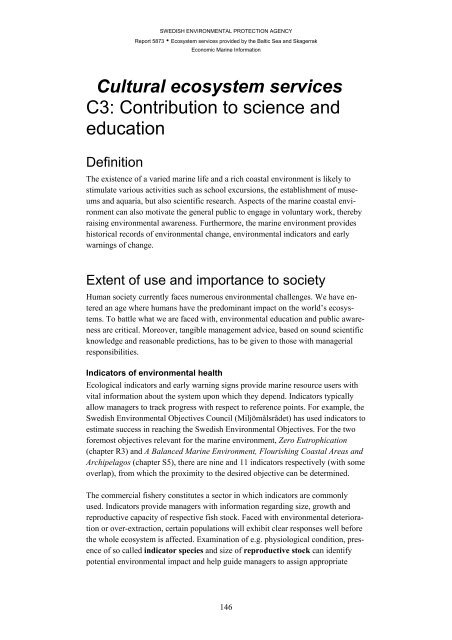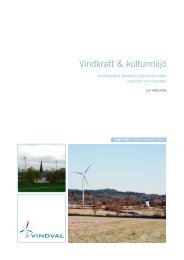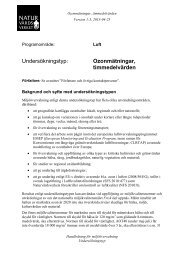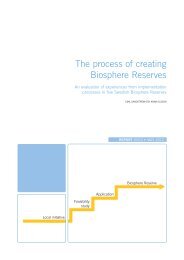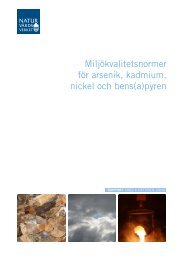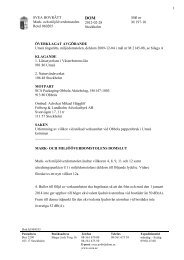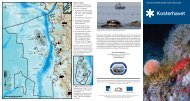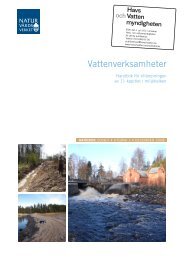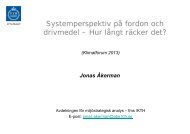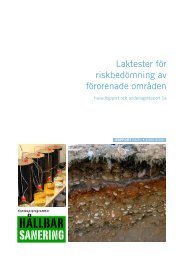Ecosystem services provided by the Baltic Sea ... - Naturvårdsverket
Ecosystem services provided by the Baltic Sea ... - Naturvårdsverket
Ecosystem services provided by the Baltic Sea ... - Naturvårdsverket
Create successful ePaper yourself
Turn your PDF publications into a flip-book with our unique Google optimized e-Paper software.
SWEDISH ENVIRONMENTAL PROTECTION AGENCY<br />
Report 5873 • <strong>Ecosystem</strong> <strong>services</strong> <strong>provided</strong> <strong>by</strong> <strong>the</strong> <strong>Baltic</strong> <strong>Sea</strong> and Skagerrak<br />
Economic Marine Information<br />
Cultural ecosystem <strong>services</strong><br />
C3: Contribution to science and<br />
education<br />
Definition<br />
The existence of a varied marine life and a rich coastal environment is likely to<br />
stimulate various activities such as school excursions, <strong>the</strong> establishment of museums<br />
and aquaria, but also scientific research. Aspects of <strong>the</strong> marine coastal environment<br />
can also motivate <strong>the</strong> general public to engage in voluntary work, <strong>the</strong>re<strong>by</strong><br />
raising environmental awareness. Fur<strong>the</strong>rmore, <strong>the</strong> marine environment provides<br />
historical records of environmental change, environmental indicators and early<br />
warnings of change.<br />
Extent of use and importance to society<br />
Human society currently faces numerous environmental challenges. We have entered<br />
an age where humans have <strong>the</strong> predominant impact on <strong>the</strong> world’s ecosystems.<br />
To battle what we are faced with, environmental education and public awareness<br />
are critical. Moreover, tangible management advice, based on sound scientific<br />
knowledge and reasonable predictions, has to be given to those with managerial<br />
responsibilities.<br />
Indicators of environmental health<br />
Ecological indicators and early warning signs provide marine resource users with<br />
vital information about <strong>the</strong> system upon which <strong>the</strong>y depend. Indicators typically<br />
allow managers to track progress with respect to reference points. For example, <strong>the</strong><br />
Swedish Environmental Objectives Council (Miljömålsrådet) has used indicators to<br />
estimate success in reaching <strong>the</strong> Swedish Environmental Objectives. For <strong>the</strong> two<br />
foremost objectives relevant for <strong>the</strong> marine environment, Zero Eutrophication<br />
(chapter R3) and A Balanced Marine Environment, Flourishing Coastal Areas and<br />
Archipelagos (chapter S5), <strong>the</strong>re are nine and 11 indicators respectively (with some<br />
overlap), from which <strong>the</strong> proximity to <strong>the</strong> desired objective can be determined.<br />
The commercial fishery constitutes a sector in which indicators are commonly<br />
used. Indicators provide managers with information regarding size, growth and<br />
reproductive capacity of respective fish stock. Faced with environmental deterioration<br />
or over-extraction, certain populations will exhibit clear responses well before<br />
<strong>the</strong> whole ecosystem is affected. Examination of e.g. physiological condition, presence<br />
of so called indicator species and size of reproductive stock can identify<br />
potential environmental impact and help guide managers to assign appropriate<br />
146


